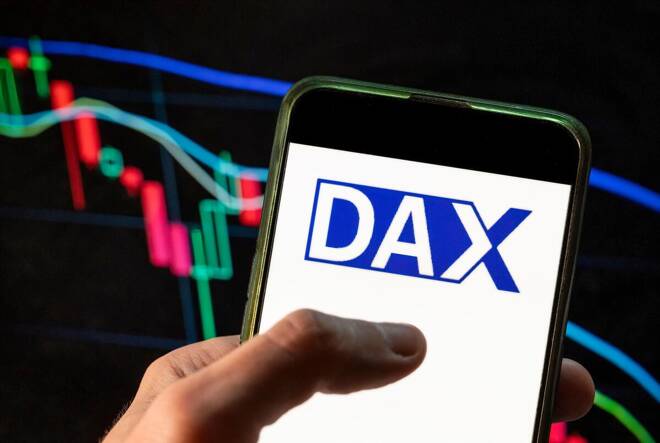Advertisement
Advertisement
DAX Set for a Bullish Open with Manufacturing PMIs in Focus
By:
It is a busy day for the DAX. Manufacturing PMIs for Eurozone member states and the Eurozone will influence ahead of the US ISM Manufacturing PMI.
Highlights
- It was a bullish end to a bullish week for the DAX on Friday, which gained 1.26% to end the day at 16,148.
- Softer inflation numbers for the Eurozone and the US and better-than-expected German retail sales figures supported a bullish session.
- Manufacturing PMI numbers from China, the euro area, and the US will influence today.
It was a bullish end to a bullish week for the DAX, which gained 1.26%. Reversing a 0.01% loss from Thursday, the DAX ended the week up 2.01% to 16,148. Significantly, the DAX wrapped up the day at 16,100 for the first time in eight sessions.
Economic indicators from Germany, the euro area, and the US supported riskier assets.
The upside came despite the US economic indicators failing to impact Fed monetary policy bets. Fed Chair Powell’s talk of consecutive interest rate hikes continued to affect Fed interest rate expectations.
According to the CME FedWatch Tool, the probability of a 25-basis point July Fed rate hike stood at 86.8% versus 71.9% one week earlier. Significantly, the chances of the Fed lifting rates to 5.75% in September stood at 20.8%, up from 11.5% one week earlier.
Economic Indicators Support Riskier Assets
It was a busy day on the European economic calendar. German retail sales and unemployment figures drew interest ahead of inflation numbers for the Eurozone.
German retail sales increased by 0.4% in May versus a 0.7% rise in April, providing early support. Eurozone inflation numbers were also bullish, with the annual inflation rate softening from 6.1% to 5.5%.
However, core inflation and German unemployment figures will provide the ECB with food for thought. The German unemployment rate unexpectedly rose from 5.6% to 5.7% in June. Stable labor market conditions have been the key to consumer spending and service sector activity. A deterioration in labor market conditions may force the ECB to rethink its policy goals.
Eurozone core inflation numbers also muddied the waters. The core inflation rate increased from 5.3% to 5.4%, with core inflation a focal point for ECB Executive Board Members.
However, US economic indicators were DAX-friendly. The Core PCE Price Index increased by 4.6% year-over-year in May versus 4.7% in April, with the PCE Price Index up 3.8% versus 4.3% in April. Personal spending was lackluster, rising by just 0.1% in May versus 0.6% in April.
While the Core PCE Price Index suggested sticky inflation, the softer numbers also raised hopes of a near-term end to the Fed’s monetary policy tightening cycle.
The Market Movers
It was a bullish Friday session for the auto sector. BMW and Continental AG led the way, with gains of 1.33% and 1.35%, respectively. Mercedes-Benz Group ended the day up 0.95%, with Volkswagen and Porsche rising by 0.42% and 0.47%, respectively.
It was also a bullish session for the banks. Commerzbank and Deutsche Bank saw gains of 1.70% and 1.32%, respectively.
Infineon and Siemens Energy AG were among the front runners, rallying by 3.14% and 3.06%, respectively. Siemens Energy continued to recover from a sharp sell-off stemming from the pulling its 2023 profit outlook.
The Day Ahead for the DAX
Earlier this morning, manufacturing PMI numbers from China set the tone.
In June, the Caixin Manufacturing PMI fell from 50.9 to 50.5 versus a forecasted 50.2. While weak overseas demand was a drag, investors responded favorably to the better-than-expected headline PMI number. The latest PMI reading supports the hope of further PBoC support to boost economic activity.
The Eurozone manufacturing sector is also in the spotlight today. PMIs from Spain and Italy and finalized numbers for France, Germany, and the Eurozone will draw interest.
However, we expect the PMIs for Italy and the Eurozone to have more influence, barring a revision to the German PMI.
Later in the session, the US ISM Manufacturing PMI will also move the dial. Economists forecast the PMI to increase from 46.9 to 47.2. A deeper contraction would weigh on riskier assets.
Investors should also consider central bank chatter. However, no ECB Executive Board Members are on the calendar to speak today, leaving commentary with the media to influence. With the ECB expected to raise rates later this month, comments relating to the September meeting would draw interest.
DAX Technical Indicators
Looking at the EMAs and the 4-hourly chart, the EMAs sent bullish signals. The DAX sat above the 50-day EMA (16,013). The 50-day EMA pulled away from the 200-day EMA, sending bullish signals.
A hold above the 50-day EMA would support a return to 16,200 and give the bulls a run at last week’s high of 16,427. However, a fall through the 50-day EMA (16,013) would bring the 200-day EMA (15,828) and last week’s low of $15,814 into view.
The 14-4H RSI sits at 62.25, sending bullish signals and supporting a breakout from 16,200 to target the 16,330 – 16,380 resistance band.
Daily Resistance & Support Levels
| R1 | 16,224 | S1 | 16,026 |
| R2 | 16,299 | S2 | 15,903 |
| R3 | 16,497 | S3 | 15,705 |
For a look at the economic events, check out our economic calendar.
About the Author
Bob Masonauthor
With over 28 years of experience in the financial industry, Bob has worked with various global rating agencies and multinational banks. Currently he is covering currencies, commodities, alternative asset classes and global equities, focusing mostly on European and Asian markets.
Advertisement
